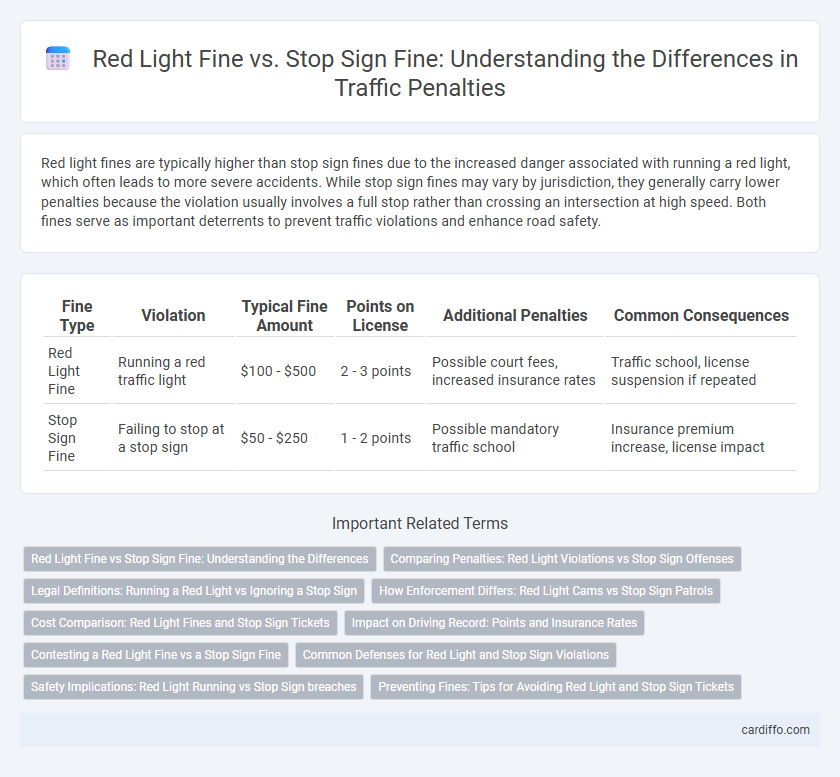Red light fines are typically higher than stop sign fines due to the increased danger associated with running a red light, which often leads to more severe accidents. While stop sign fines may vary by jurisdiction, they generally carry lower penalties because the violation usually involves a full stop rather than crossing an intersection at high speed. Both fines serve as important deterrents to prevent traffic violations and enhance road safety.
Table of Comparison
| Fine Type | Violation | Typical Fine Amount | Points on License | Additional Penalties | Common Consequences |
|---|---|---|---|---|---|
| Red Light Fine | Running a red traffic light | $100 - $500 | 2 - 3 points | Possible court fees, increased insurance rates | Traffic school, license suspension if repeated |
| Stop Sign Fine | Failing to stop at a stop sign | $50 - $250 | 1 - 2 points | Possible mandatory traffic school | Insurance premium increase, license impact |
Red Light Fine vs Stop Sign Fine: Understanding the Differences
Red light fines are generally higher than stop sign fines due to the increased risk of accidents caused by running a red light, which often results in more severe collisions. Stop sign fines typically focus on ensuring drivers come to a complete stop to prevent side-impact crashes, making their penalties less severe but crucial for intersection safety. Understanding these differences helps drivers recognize the importance of compliance with traffic signals to avoid costly fines and enhance road safety.
Comparing Penalties: Red Light Violations vs Stop Sign Offenses
Red light violations typically result in higher fines and more severe penalties due to the increased risk of collisions at intersections compared to stop sign offenses. Red light fines can range from $100 to $500, often accompanied by points on the driver's license and potential increases in insurance premiums. Stop sign fines are generally lower, usually between $50 and $200, with fewer associated penalties unless repeated offenses occur.
Legal Definitions: Running a Red Light vs Ignoring a Stop Sign
Running a red light legally constitutes failing to stop at a traffic signal displaying a red indication, which is often considered a moving violation with stricter penalties due to higher accident risks. Ignoring a stop sign involves not coming to a complete stop at an intersection marked by a stop sign, typically treated as a less severe traffic offense but still subject to fines and points on the driver's license. Both infractions fall under traffic law violations but differ in legal definitions, enforcement severity, and potential consequences based on jurisdiction-specific regulations.
How Enforcement Differs: Red Light Cams vs Stop Sign Patrols
Red light fines are primarily enforced through automated red light cameras that capture vehicles running red signals, providing photographic evidence for citations without requiring officer presence at the intersection. Stop sign fines typically rely on active police patrols, where officers visually confirm infractions, enabling immediate ticket issuance but limiting enforcement coverage. The disparity in enforcement methods results in higher detection rates for red light violations versus stop sign offenses, influencing compliance behavior and fine collection outcomes.
Cost Comparison: Red Light Fines and Stop Sign Tickets
Red light fines typically range from $100 to $500, reflecting the higher risk associated with running a red light compared to stop sign violations, which usually incur fines between $50 and $200. Insurance premiums often increase more significantly after red light ticket citations due to the potential severity of accidents involved. The cost disparity emphasizes the importance of obeying traffic signals to avoid substantial financial penalties and increased insurance costs.
Impact on Driving Record: Points and Insurance Rates
Red light fines typically add more points to a driving record than stop sign fines, leading to higher increases in insurance premiums. Accumulating points from red light violations can trigger policy surcharges and even license suspensions faster than stop sign offenses. Insurance companies view red light infractions as more severe, resulting in greater financial impacts on drivers compared to stop sign fines.
Contesting a Red Light Fine vs a Stop Sign Fine
Contesting a red light fine often involves reviewing traffic camera evidence and timing of the light change, whereas disputing a stop sign fine typically requires proving a complete stop or challenging the sign's visibility. Red light violations usually carry higher fines and points on a driving record compared to stop sign infractions, making precise contest strategies crucial. Understanding local traffic laws and gathering witness statements can significantly impact the success of contesting either type of fine.
Common Defenses for Red Light and Stop Sign Violations
Common defenses for red light and stop sign violations often involve challenging the accuracy of traffic signal timing and the reliability of camera evidence. Drivers may argue that the light changed too quickly or malfunctioned, or that the stop sign was obscured by foliage or poorly placed, leading to unintentional violations. Evidence such as dashcam footage and witness statements can be crucial in disputing these traffic fines effectively.
Safety Implications: Red Light Running vs Stop Sign breaches
Red light violations pose a higher risk of severe collisions due to high-speed cross-traffic, increasing the likelihood of T-bone accidents and pedestrian injuries. Stop sign breaches generally occur at lower speeds but still compromise intersection safety by reducing driver predictability and increasing side-impact crash potential. Enforcement of red light fines significantly enhances compliance, thereby reducing critical accidents compared to stop sign fine enforcement.
Preventing Fines: Tips for Avoiding Red Light and Stop Sign Tickets
Avoiding red light and stop sign fines requires consistent adherence to traffic signals and proper intersection behavior. Drivers should approach intersections cautiously, making complete stops at stop signs and waiting for green lights before proceeding through red lights. Using defensive driving techniques and staying alert to changing signals significantly reduces the risk of citations and promotes safe road practices.
Red Light Fine vs Stop Sign Fine Infographic

 cardiffo.com
cardiffo.com